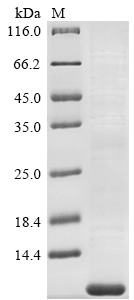Amino acids 112-188 form the expressed segment for recombinant Human TSPAN2. This TSPAN2 protein is expected to have a theoretical molecular weight of 8.8 kDa. This TSPAN2 recombinant protein is manufactured in e.coli. The TSPAN2 coding gene included the Tag-Free, which simplifies the detection and purification processes of the recombinant TSPAN2 protein in following stages of expression and purification.
Tetraspanin-2 (TSPAN2) is a transmembrane protein belonging to the tetraspanin superfamily. It is widely expressed in various tissues and is involved in multiple cellular processes. TSPAN2 is known to associate with other membrane proteins, forming molecular complexes called tetraspanin-enriched microdomains (TEMs) or tetraspanin web. These complexes play crucial roles in modulating signal transduction, cell adhesion, and membrane organization. TSPAN2 has been implicated in diverse cellular functions, including immune responses, cell migration, and cancer progression. Its interactions with other tetraspanins and associated proteins contribute to the regulation of intracellular signaling pathways. Understanding the specific roles of TSPAN2 in different contexts, such as immune cell function and cancer biology, is essential for elucidating its potential as a therapeutic target and its broader implications in cellular physiology.






